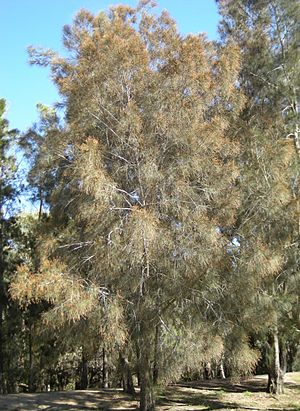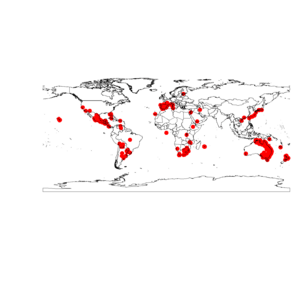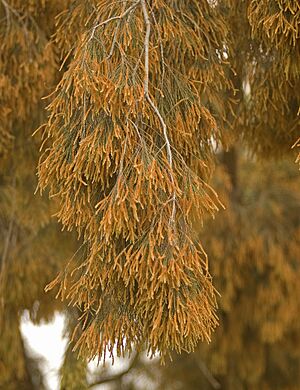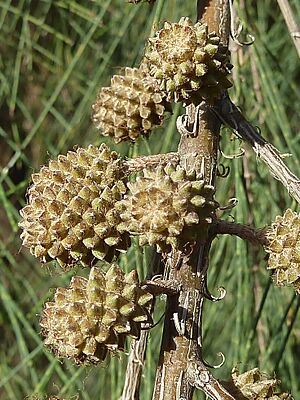River oak facts for kids
Quick facts for kids River oak |
|
|---|---|
 |
|
| Casuarina cunninghamiana tree in flower. | |
| Scientific classification | |
| Genus: |
Casuarina
|
| Species: |
cunninghamiana
|
 |
|
| Occurrence data from GBIF[ | |
The River Oak (scientific name: Casuarina cunninghamiana) is a special type of tree. It is also known as the river she-oak. This tree belongs to a group of plants called she-oaks.
River Oaks grow naturally in Australia. You can find them from the Daly River in the Northern Territory. They also grow across Queensland and eastern New South Wales.
Contents
Discover the River Oak Tree
The River Oak is an evergreen tree. This means it keeps its leaves all year round. Its leaves look like fine, grey-green needles.
These trees can grow very tall. They reach heights of 10 to 35 meters (about 33 to 115 feet). Their branches can spread out about 10 meters (33 feet) wide. The tree usually has a straight trunk. Its bark is rough and thick.
River Oak trees have small flowers. Male flowers are reddish-brown. Female flowers are red. After flowering, they produce small cones. These cones are almost round or a bit long. They are about 10 millimeters (0.4 inches) across.
Where River Oaks Grow
River Oak trees love sunny places. They are often found along riverbanks. You can also see them in swampy areas. These trees are very important for nature. They help keep riverbanks strong. This stops the soil from washing away.
River Oaks can grow in both wet and dry soils. Their leaves are a good food source for farm animals. These trees can handle cold weather. They can survive temperatures as low as about -8 degrees Celsius (18 degrees Fahrenheit).
People often plant River Oaks to create screens. They are also good for windy places. You can even find them growing near the coast. Some countries have planted River Oaks for agroforestry. This means growing trees for both wood and other farm products.
Types of River Oak Trees
There are two main types, or subspecies, of the River Oak:
- C. cunninghamiana subsp. cunninghamiana: This type is a large tree. It can grow up to 35 meters (115 feet) tall. You can find it in eastern New South Wales and northern and eastern Queensland.
- C. cunninghamiana subsp. miodon: This type is a smaller tree. It grows up to 12 meters (39 feet) tall. It is found near the Daly River and Arnhem Land in the Northern Territory. It also grows near the Gulf of Carpentaria in Queensland.
People call this tree by many names. These include River Oak, River She-oak, or Creek Oak.
River Oaks as Invasive Species
Sometimes, a plant or animal grows in a new place. If it spreads quickly and harms the local environment, it's called an invasive species. The River Oak, Casuarina cunninghamiana, has become an invasive species in some areas. For example, it has spread too much in the Everglades in Florida. It is also an invasive species in South Africa.
See also
 In Spanish: Casuarina cunninghamiana para niños
In Spanish: Casuarina cunninghamiana para niños



